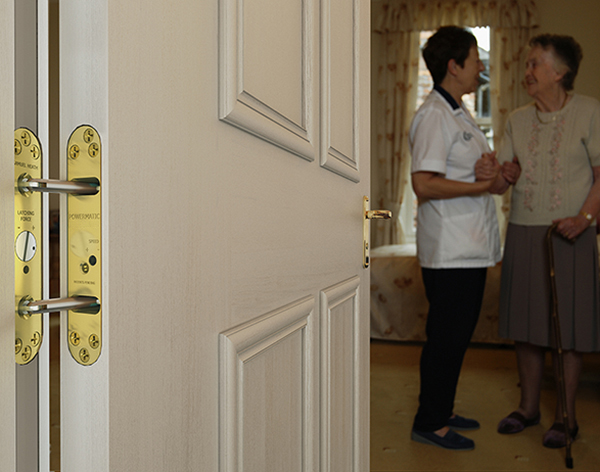Self-closing fire doors are essential for containing fires in buildings and giving occupants the opportunity to escape.
Self-closing fire doors are central to fire safety legislation for multi-occupant buildings such as social housing, healthcare facilities, mental health units, education sites, student accommodation and hotels. Landlords and many businesses must adhere to fire safety laws and building regulations outlined in Approved Document B which stipulate the installation of self-closing fire doors in non-domestic buildings.
The function of self-closing technology is to ensure that the door shuts correctly to create a tight seal. The door then provides a barrier against the spread of smoke and flames to other areas of a building. If doors are left open, smoke and flames are able to spread rapidly, often with tragic consequences.
Samuel Heath is a leading brand in self-closing door technology. As an alternative to traditional, overhead fire door closers, we developed market-leading concealed door closers that are hidden between the door and the door frame. When the door is shut, the door closer is not visible.
Our self-closing hydraulic concealed door closers are now used in multi-occupant and public buildings across the world.

Benefits of self-closing fire doors for social housing and healthcare environments
In multi-occupant settings such as social housing and healthcare environments, self-closing fire doors are an essential safety requirement.
Some of the benefits of self-closing fire doors for social housing and healthcare environments are:
- Prevention of the spread of smoke and flames
- Easier coming and going of wheelchairs, hospital beds and prams
- Prevention of opening doors too quickly or in windy locations which can cause injury and door damage
- Security for people in a property or building.
At Samuel Heath we would advocate that while traditional overhead fire door closers do the job of closing a door automatically in social housing and healthcare environments, being visible they are at risk of vandalism and damage. They also present a ligature risk by offering an easy suspension point.
Concealed self-closing door technology is unlikely to be vandalised or damaged by social housing residents who don’t want their doors to automatically close. Being installed much lower than overhead door closers, concealed door closers also present almost zero ligature risk. In healthcare facilities, concealed door closers don’t offer a surface for the collection of dust and debris that can be harmful to people with chronic conditions.
Performance and quality
The Powermatic R100 and Powermatic Axis R108 concealed self-closing door technology products from Samuel Heath are synonymous with performance and quality:
- CE marked
- UKCA marked
- Factory production control to BS EN ISO 9001: 2015
- Suitable for doors up to 80kg in weight and 950mm wide (BS EN 1154 size 3 test door 60kg)
- Adjustable closing speed and power latching action
- Endurance tested to 500,000 cycles
- Unique twin power mechanism
- 10-year guarantee
The Powermatic R100 is also the only Certifire approved (independent accreditation from a leading fire safety authority) jamb-mounted concealed door closer.
Specify Samuel Heath self-closing fire door technology for healthcare settings and social housing
Contact the team at Samuel Heath to discuss self-closing fire door technology for your project.

FAQs
Can concealed door closers be easily inspected and adjusted?
Yes. A professional tradesperson can make any adjustments necessary.
Do the Powermatic R100 and Powermatic R108 meet the requirements of Approved Document B?
Yes
What happens if an overhead fire door closer is damaged or vandalised?
The fire safety of the door is completely compromised which usually results in a full, costly replacement of the door.
